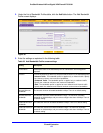
Firewall Protection
175
ProSafe Wireless-N 8-Port Gigabit VPN Firewall FVS318N
Create Bandwidth Profiles
Bandwidth profiles determine the way in which data is communicated with the hosts. The
purpose of bandwidth profiles is to provide a method for allocating and limiting traffic, thus
allocating LAN users sufficient bandwidth while preventing them from consuming all the
bandwidth on your WAN link. A single bandwidth profile can be for both outbound and
inbound traffic.
For outbound IPv4 traffic, you can apply bandwidth profiles on the WAN interface; for inbound
IPv4 traffic, you can apply bandwidth profiles to a LAN interface. Bandwidth profiles do not
apply to the DMZ interface, nor to IPv6 traffic.
When a new connection is established by a device, the device locates the firewall rule
corresponding to the connection:
• I
f the rule has a bandwidth profile specification, the device creates a bandwidth class in
the kernel.
• I
f multiple connections correspond to the same firewall rule, the connections all share the
same bandwidth class.
An exception occurs for an individual
bandwidth profile if the classes are per-source IP
address classes. The source IP address is the IP address of the first packet that is
transmitted for the connection. So for outbound firewall rules, the source IP address is the
LAN-side IP address; for inbound firewall rules, the source IP address is the WAN-side IP
address. The class is deleted when all the connections that are using the class expire.
After you have created a bandwidth profile, you can assign the bandwidth profile to firewall
rules on the following screens:
• Add
LAN WAN Outbound Services screen for IPv4 (see Figure 65 on page 141)
• Add
LAN WAN Inbound Services screen for IPv4 (see Figure 67 on page 144)
To add and enable a bandwidth profile:
1. Select Se
curity > Bandwidth Profiles. The Bandwidth Profiles screen displays. (The
following figure shows some examples.)
Figure 94.


















